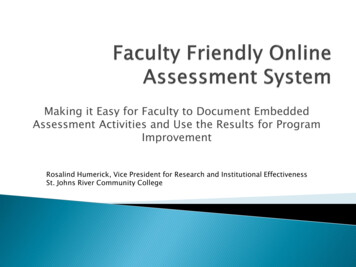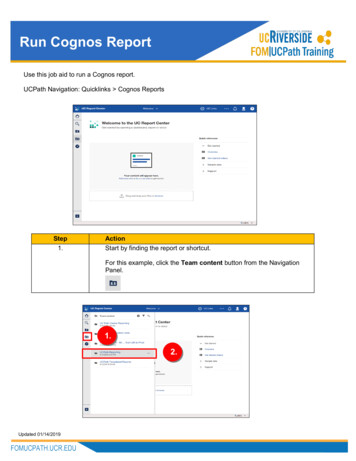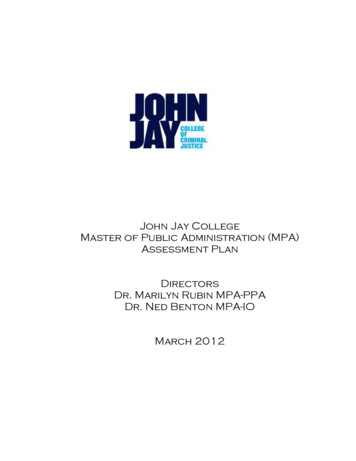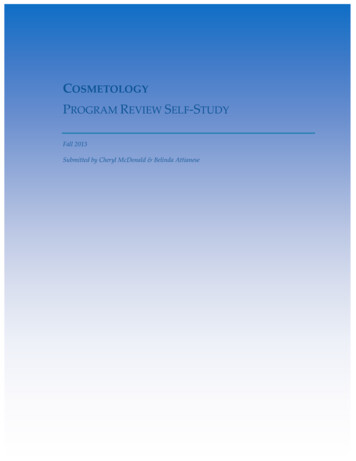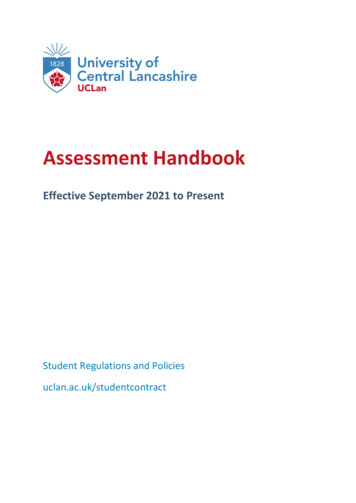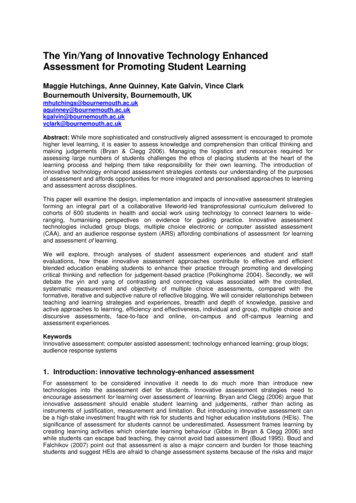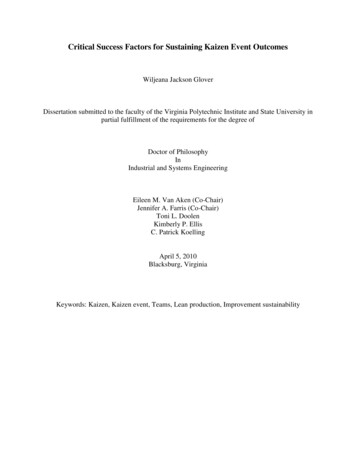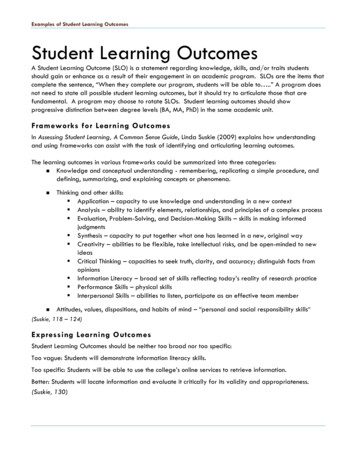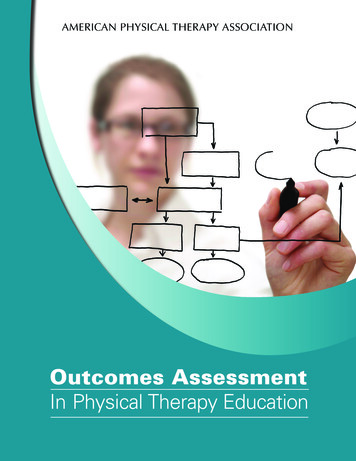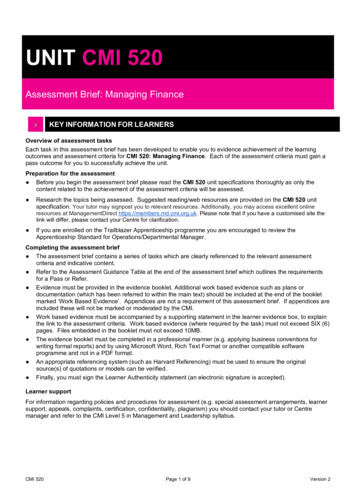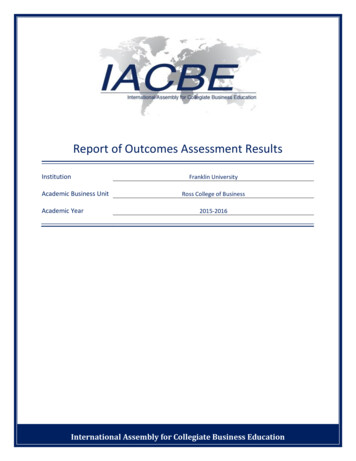
Transcription
Report of Outcomes Assessment ResultsInstitutionAcademic Business UnitAcademic YearFranklin UniversityRoss College of Business2015-2016International Assembly for Collegiate Business Education
Outcomes Assessment PlanIs the outcomes assessment plan that you submitted to the IACBE still current or have you madechanges?The outcomes assessment plan that we have previously submitted is still current.Changes have been made and the revised plan is attached.xWe have made changes and the revised plan will be sent to the IACBE by:January 28, 2017i
DirectionsComplete the Outcomes Assessment Results form below. Note: Section II of the form (OperationalAssessment) needs to be completed only if you received first-time accreditation or reaffirmation ofaccreditation after January 1, 2011.An example of a completed form can be found in a separate document that is available for download onthe IACBE’s website at: www.iacbe.org/accreditation-documents.asp.Section I (Student Learning Assessment) of the Outcomes Assessment Results form must be completedfor each business program that is accredited by the IACBE (i.e., a separate table must be provided foreach program).Add tables, and insert or delete rows in the tables as needed in order to accommodate the number ofyour (i) business programs, (ii) intended student learning outcomes, and (iii) intended operationaloutcomes. In the sections of the assessment results tables entitled “Summary of Achievement ofIntended Student Learning Outcomes” and “Summary of Achievement of Intended OperationalOutcomes,” DO NOT ADD OR DELETE COLUMNS. Space is provided in these sections for four directmeasures of student learning, four indirect measures of student learning, and eight operationalassessment measures/methods. If you are employing fewer than this number of assessmentinstruments, simply leave cells in the unused columns blank. If you are employing more than thisnumber of instruments, you will need to create additional summary-of-achievement tables to reportyour assessment information.In the sections of the assessment results tables entitled “Summary of Achievement of Intended StudentLearning Outcomes” and “Summary of Achievement of Intended Operational Outcomes,” enter “Met” ina given cell of the table if the performance target for the instrument in that column was achieved for theintended outcome in that row; “Not Met” if the performance target for the instrument in that columnwas not achieved for the intended outcome in that row; or “NA” (Not Assessed) if the instrument inthat column does not measure the intended outcome in that row.At the bottom of each assessment results table, space is provided to identify changes and improvementsthat you plan to make as a result of your assessment activity.Italicized entries in the form represent areas where the academic business unit should insert its ownassessment information.Please be sure to delete these directions before submitting your form to the IACBE.ii
Outcomes Assessment ResultsFor Academic Year:2015-2016Section I: Student Learning AssessmentStudent Learning Assessment for: Associate of Science, AccountingProgram Intended Student Learning Outcomes (Program ISLOs)1. Graduates will demonstrate technical accounting skills in intermediate-level accounting topics/concepts.2. Graduates will demonstrate the ability to research and analyze specific intermediate-level accounting issues.3. Graduates will demonstrate oral and written communication skills.4. Graduates will demonstrate the ability to research and analyze specific federal income tax issues related to the taxation of individuals.Assessment Instruments for Intended Student Learning Outcomes—Direct Measures of Student Learning:Exam scores in both ACCT 310, Intermediate Accounting I and ACCT 320,Intermediate Accounting II.ACCT 320: Intermediate Accounting II – “U.S. GAAP vs. IFRS Research andPresentation” assignment.ACCCT 390: Federal Income Taxation I – “Tax Research Memo # 4”assignment.Assessment Instruments for Intended Student Learning Outcomes—Indirect Measures of Student Learning:Performance Objectives (Targets/Criteria) for Direct Measures:In 70% or above instances for each criterion, students scored at or aboveeither the 70% mark (“Acceptable”) or 80% mark (“Proficient”).In 70% or above instances for each criterion, students scored at or aboveeither the 70% mark (“Acceptable”) or 80% mark (“Proficient”).In 70% or above instances for each criterion, students scored at or aboveeither the 70% mark (“Acceptable”) or 80% mark (“Proficient”).Performance Objectives (Targets/Criteria) for Indirect Measures:1. Graduating Student SurveyAt least 90% of graduating students in the school of business in which themajor in Accounting is reported will be satisfied with the content of theircurriculum and at least 90% of graduating students in the school ofbusiness in which the major in Accounting is reported will be satisfiedwith their major program courses.2. Student End of Course SurveyThe average percentages of course recommend and faculty recommendfor the Accounting program would be 80% or higher.1
3. Faculty Post-Course InterviewsFaculty consensus on all four criteria is above average (i.e., coursequality, relevance, innovation and consistency.Learning Assessment Results: Associate of Science, AccountingSummary of Results from Implementing Direct Measures of Student Learning:1. Outcome 1: There were six (6) AS in Accounting students in ACCT 310 and nine (9) AS in Accounting students in ACCT 320 in the 2015-2016academic year identified. The limited AS student in Accounting makes it statistically difficult to develop definitive conclusions about measures ofstudent learning. Additionally, some AS students transferred in one or more of the accounting courses required for the degree. Acknowledgingthese limitations, in ACCT 310, in Test 1, Test 2, Test 3 and Test 4, 79, 87%, 82% and 86%, respectively, met the “Acceptable” or “Proficient”criterion. In ACCT 320, in Test 1, Test 2, Test 3 and Test 4, 72%, 69%, 75% and 77%, respectively, met the “Acceptable” or “Proficient” criterion.Thus, during this time period, the limited pool of AS students did meet the “Acceptable” or “Proficient” in 70% or above instances for each criterionregarding exam scores except for ACCT 320 exam 2.2. Outcomes 2 and 3: There were nine (9) AS in Accounting students in the 2015-2016 academic year identified. The limited AS student inAccounting makes it statistically difficult to develop definitive conclusions about measures of student learning. Additionally, some AS studentstransferred in one or more of the accounting courses required for the degree. However, during the AY 2015-2016 assessment period, the student’saverage grade was 93%, representing Proficient on the criterion of the “US GAAP vs. IFRS Research & Presentation” assignment. The scoredemonstrates that the students have the ability to research and analyze specific intermediate-level accounting issues and demonstrates proficientoral and written communication skills.3. Outcomes 3 and 4: There were nine (9) AS in Accounting students in the 2015-2016 academic year identified. The limited AS student inAccounting makes it statistically difficult to develop definitive conclusions about measures of student learning. Additionally, some AS studentstransferred in one or more of the accounting courses required for the degree. However, during the AY 2015-2016 assessment period, the student’saverage grade was 94%, representing Proficient on the criterion of the “Tax Research Memo # 4” assignment. The score demonstrates that thestudents have the ability to research and analyze specific federal income tax issues and demonstrates proficient oral and written communicationskills.Summary of Results from Implementing Indirect Measures of Student Learning:1. Graduating Student Survey: Response to satisfaction with “Content of Curriculum” question on Graduating Student Survey for Winter Term 2016was 42% “Very Satisfied”, 50% “Somewhat Satisfied”,and 8% “Somewhat Dissatisfied”. : Response to satisfaction with “Major Program Courses”question on Graduating Student Survey for Winter Term 2016 was 67% “Very Satisfied”, 25% “Somewhat Satisfied” and 8% “SomewhatDissatisfied”.2. Student End of Course Survey: The average percentage of recommend accounting course for AY 2015-2016 was 89.6% and the averagepercentage of recommend accounting faculty was 90.9% for AY 2015-2016. This is an increase of 3.4% and 3.7% respectively.2
3. Faculty post-course interviews: Ongoing feedback obtained at the end of each term and during the annual faculty meeting indicates that thefaculty consensus on all four assessment criteria with respect to the course quality, relevance, innovation and consistency was Acceptable orProficient for not only each course, but also for the accounting program overall.Summary of Achievement of Intended Student Learning Outcomes:Intended Student Learning OutcomesProgram ISLOs1.Graduates will demonstrate technicalaccounting skills in intermediate-levelaccounting topics/concepts.Learning Assessment MeasuresDirectMeasure 1:Exam Scoresin ACCT 310and 320DirectMeasure 2:“US GAAP vsIFRSResearch andPresentation”DirectMeasure 3:“TaxResearchMemo #4”PerformanceTarget Was PerformanceTarget Was PerformanceTarget Was IndirectMeasure 2:Student Endof CourseSurveyIndirectMeasure 3:Faculty PostCourseInterviewsIndirectMeasure 4PerformanceTarget Was PerformanceTarget Was PerformanceTarget Was PerformanceTarget Was PerformanceTarget Was MetMetMetMetMetMetMetMetMetMetMetMetMetMetMet2. Graduates will demonstrate theability to research and analyze specificintermediate-level accounting issues.Met3.Graduates will demonstrate oral andwritten communication skills.Met4.Graduates will demonstrate theability to research and analyze specificfederal income tax issues related to thetaxation of individuals.DirectMeasure 4IndirectMeasure 1:GraduatingStudentSurveyProposed Courses of Action for Improvement in Learning Outcomes for which Performance Targets Were Not Met:1. Students identified as A.S. students in Intermediate Accounting will be monitored closely throughout the year to afford the students the ability toa) receive instructor assistance as necessary; b) adaptive learning opportunities in McGraw Hill Connect; and c) identification for assistance to theFranklin University Student Learning Center.2. Although indirect measures performance targets were met for 1, 2, and 3, these indirect measures will be replaced by a reflection paper andsurvey for 2017-2018 that specifically relate to program ISLOs.3
Outcomes Assessment ResultsFor Academic Year:2015-16Section I: Student Learning AssessmentStudent Learning Assessment for Associate of Science (AS) – Business AdministrationIntended Student Learning Outcomes for Associate of Science in Business Administration:1. Describe the functions, roles, and skills of a manager.2. Evaluate the planning, organizing, leading, and controlling functions of a business using stated criteria.3. Write and present error-free arguments for an internal business audience.Assessment Tools for Intended Student Learning Outcomes—Direct Measures of Student Learning:1. Grading outcome results for the primary course and assignments forthe Associate of Science for Business Administration:MGMT 312 Management Dilemma: Outcomes 1 and 3MGMT 312 Historical Perspective of Mgmt: Outcomes 2 and 3MGMT 312 Presentation: Outcome 3Assessment Tools for Intended Student Learning Outcomes—Indirect Measures of Student Learning:Performance Targets/Criteria for Direct Measures:The average student achievement score for the assessed assignments inthe foundation course will be above the performance target of 70%Performance Targets/Criteria for Indirect Measures:1. Graduating Student Survey ResultsResults will reflect students were satisfied with the associate degreecurriculum at or above an 85% satisfaction level.2. Faculty EvaluationsFaculty in the Associate of Business Administration program will receivea recommendation rate of 85% or higher.3. Course EvaluationsCourses in in the Associates of Business Administration program willreceive a recommendation rate of 85% or higher.4. Program Advisory BoardThe Business Administration Advisory Board will meet at least once peryear to make recommendations on curriculum changes. The board will4
provide recommendations on curriculum alignment with today’sbusiness environment.5. Adjunct Faculty Retreats and CommunicationsTeaching faculty within the Business Administration program will meet(in-person or via teleconference) at least once per year to discuss courselevel outcomes, course relevancies, and review any course changes.Summary of Results from Implementing Direct Measures of Student Learning:Performance Target Was Met1. MGMT 312 Management Dilemma: Outcomes 1 and 3 – average grade 93%MGMT 312 Historical Perspective of Mgmt: Outcomes 2 and 3 – average grade 96%MGMT 312 Presentation: Outcome 3– average grade 94%Summary of Results from Implementing Indirect Measures of Student Learning:XPerformance Target Was Met1. Graduating Student Survey Results were not available this academic year.Not MetNot MetNotAvailable2. The aggregate scores of the overall undergraduate Business Administration Program course evaluations showed a& 91.9% recommend by students and the instructor evaluations for this academic year reflected a 93% recommend3. by students. Although segmenting these by the significantly lower number of associate degree students was notfeasible, the total results reflected very favorably upon recommendations by associate degree only students.X4. The Business Administration Advisory Board met once during this academic year in May to review changes to theprogram curriculum and formulate recommendations on program improvements. The meeting focused on makingthe BSAD program more transfer friendly in order to increase enrollment in the program. The AS and BS AdvisoryBoard is the same.X5. The AS faculty and the Business Administration (BSAD) Adjunct Faculty are combined and met via phoneconference this academic year. Main topic was number of sections offered and staffing. Additionally, a number ofindividual meetings and phone meetings were held throughout the academic year.XProposed Courses of Action for Improvement in Areas for which Performance Targets Were Not Met:1.Learning Improvement: Please identify how learning has improved upon the implementation of action items from previous years5
Students in the AS program are doing well and the outcomes are being met. Given the success of these students we are working on strategies tomove more students into the BSAD program.6
Outcomes Assessment ResultsFor Academic Year:2015-2016Section I: Student Learning AssessmentStudent Learning Assessment for: AS, Financial ManagementProgram Intended Student Learning Outcomes (Program ISLOs)1. Graduates will be able to conduct analyses of financial statements.2. Graduates will be able to utilize time-value-of-money techniques in the valuation of securities.3. Graduates will be able to compare capital investment opportunities using capital budgeting tools.4. Graduates will be able to identify the functions of financial markets and institutions and examine their impact on the level of interest rates andinterest rate differentials.5. Graduates will be able to appraise the risk and return of various investments and their combination in the creation and management ofinvestment portfolios.Assessment Instruments for Intended Student Learning Outcomes—Direct Measures of Student Learning:Performance Objectives (Targets/Criteria) for Direct Measures:1. Online quizProgram ISLOs Assessed by this Measure: Outcomes 1, 2, and 3Score at or above 70% on relevant quiz questions in quizzes 1, 2, and 3 inFINA 3012. Application of evaluation rubrics to student workProgram ISLOs Assessed by this Measure: Outcome 4“Acceptable” or “Proficient” met in 70% or above in Final Project Reportsin FINA 3403. Application of evaluation rubrics to student work“Acceptable” or “Proficient” met in 70% or above in Portfolio Project(part III)-Risk-Adjusted Return Analyses in FINA 405Program ISLOs Assessed by this Measure: Outcome 5Assessment Instruments for Intended Student Learning Outcomes—Indirect Measures of Student Learning:Performance Objectives (Targets/Criteria) for Indirect Measures:1. Graduating Student Survey: Percent Recommend: FINA Courses85% or above overall satisfaction with programProgram ISLOs Assessed by this Measure: N/A7
2. Graduating Student Survey: Percent Recommend: FINA FacultyProgram ISLOs Assessed by this Measure: N/A85% or above overall satisfaction with programLearning Assessment Results: AS, Financial ManagementSummary of Results from Implementing Direct Measures of Student Learning:In the 2015-2016 academic year online results for quiz 1 in FINA 301-Principles of Finance the average score for AS students was 95% (77% in 20142015; 81% in 2013-2014)In the 2015-2016 academic year online results for quiz 1 in FINA 301-Principles of Finance the average score for AS students was 95% (77% in 20142015; 81% in 2013-2014)In the 2015-2016 academic year online results for quiz 3 in FINA 301-Principles of Finance the average score for AS students was 69% (73% in 20142015; 53% in 2013-2014)In the 2015-2016 academic year results for Bank Portfolio-Final Analysis in FINA 340 for AS students the average score was (88% in 2014-2015;94% in 2013-2014)In the 2015-2016 academic year the Portfolio Project (part III)-Risk-Adjusted Return Analyses in FINA 405 for AS students average score was(100% in 2014-2015; 94.75% in 2013-2014)Summary of Results from Implementing Indirect Measures of Student Learning:4. N/A5. N/A6. Summary of Results for Indirect Measure 37. Summary of Results for Indirect Measure 4Summary of Achievement of Intended Student Learning Outcomes:Intended Student Learning OutcomesProgram ISLOsLearning Assessment MeasuresDirectMeasure 1DirectMeasure 2DirectMeasure 3DirectMeasure 4IndirectMeasure 1IndirectMeasure 2IndirectMeasure 3IndirectMeasure 48
PerformanceTarget Was 1. Program Learning Outcome 12. Program Learning Outcome 23. Program Learning Outcome 3PerformanceTarget Was PerformanceTarget Was PerformanceTarget Was PerformanceTarget Was PerformanceTarget Was PerformanceTarget Was PerformanceTarget Was MetMetMet4. Program Learning Outcome 45. Program Learning Outcome 5Proposed Courses of Action for Improvement in Learning Outcomes for which Performance Targets Were Not Met:3. Course of Action 14. Course of Action 25. Course of Action 36. Course of Action 49
Outcomes Assessment ResultsFor Academic Year:2015 - 2016Section I: Student Learning AssessmentStudent Learning Assessment for: Associate of Science (AS) – Forensic AccountingProgram Intended Student Learning Outcomes (Program ISLOs)1. Graduates will demonstrate technical accounting skills in intermediate-level accounting topics/concepts.2. Graduates will demonstrate the ability to research and analyze specific intermediate-level accounting issues.3. Graduates will demonstrate oral and written communication skills.4. Graduates will demonstrate the ability to research and analyze fraudulent activities in an organization and recommend needed internal controlmeasures.Assessment Instruments for Intended Student Learning Outcomes—Direct Measures of Student Learning:1. ISLO # 1: Exam scores in both ACCT 310, Intermediate Accounting 1and ACCT 320, Intermediate Accounting II.2. ISLO # 2: ACCT 320 – Intermediate Accounting II, “U. S. GAAP vs. IFRSResearch & Presentation” assignment.3. ISLOs # 3 & 4: ACCT 341 – Fraud Examination, – “Occupational FraudResearch Paper” Assignment.Performance Objectives (Targets/Criteria) for Direct Measures:In 70% or above instances for each criterion, students scored at or aboveeither the 70% mark (“Acceptable”) or the 80% mark (“Proficient”).In 70% or above instances for each criterion, students scored at or aboveeither the 70% mark (“Acceptable”) or the 80% mark (“Proficient”).In 70% or above of the instances for each criterion, students scored at orabove either the 70% mark (“Acceptable”) or 80% mark (“Proficient”).10
Assessment Instruments for Intended Student Learning Outcomes—Indirect Measures of Student Learning:1. ISLOs # 1, 2, 3, and 4: Graduating Student Reflection Survey (to beembedded in ACCT 495).Performance Objectives (Targets/Criteria) for Indirect Measures:Using the Reflection Survey, students will rate to what extent they thinkthis program has prepared them to meet the learning outcomes, basedon ratings of Below, At, or Above expectations. For each LearningOutcome, at least 80% of students’ responses will meet or exceed the “AtExpectations” or “Above Expectations” mark.Learning Assessment Results: Associate of Science (AS) – Forensic AccountingSummary of Results from Implementing Direct Measures of Student Learning:1. ISLO # 1: There was one (1) AS in Forensic Accounting student in AY 2015-2016 reflected in ACCT 310, Intermediate Accounting I. The student’saverage score for the four exams in ACCT 310 was 70% (Acceptable). Having one or no students makes it statistically impossible to developdefinitive conclusions about measures of student learning. Addisionally, some AS students transferred in one or more of the accounting coursesrequired for the degree.2. ISLO # 2: There was one (1) AS in Forensic Accounting student in AY 2015-2016 reflected in ACCT 320, Intermediate Accounting II. The student’saverage score for the four exams in ACCT 320 was 67.3% (Unacceptable). Having one or no students makes it statistically impossible to developdefinitive conclusions about measures of student learning. Addisionally, some AS students transferred in one or more of the accounting coursesrequired for the degree.3. ISLO # 3 & 4: There were two (2) AS in Forensic Accounting students in AY 2015-2016 reflected in ACCT 341, Fraud Examination. Only 1 studentcompleted the criterion assignment, receiving a score of 100%, or Proficient. Having only two students makes it statistically impossible to developdefinite conclusions about measures of student learning.11
Summary of Results from Implementing Indirect Measures of Student Learning:1. Graduating Student Reflection Survey: For each Learning Outcome, 80% of students’ responses met or exceeded the “At Expectations” or“Above Expectations” mark.Summary of Achievement of Intended Student Learning Outcomes:Intended Student Learning OutcomesProgram ISLOs1. Program Learning Outcome 12. Program Learning Outcome 2Learning Assessment MeasuresDirectMeasure 1DirectMeasure 2DirectMeasure 3DirectMeasure 4IndirectMeasure 1IndirectMeasure 2IndirectMeasure 3IndirectMeasure 4PerformanceTarget Was PerformanceTarget Was PerformanceTarget Was PerformanceTarget Was PerformanceTarget Was PerformanceTarget Was PerformanceTarget Was PerformanceTarget Was MetNot Met3. Program Learning Outcome 3Met4. Program Learning Outcome 4MetProposed Courses of Action for Improvement in Learning Outcomes for which Performance Targets Were Not Met:1. Course of Action 1 – Not applicable.2. Course of Action 2 - ISLO # 2: No course of action is planned at this time, due to low enrollment of students in this program.3. Course of Action 3 – Not applicable.4. Course of Action 4 – Not applicable.12
Outcomes Assessment ResultsFor Academic Year:2015-2016Section I: Student Learning AssessmentStudent Learning Assessment for: Bachelor of Science, AccountingProgram Intended Student Learning Outcomes (Program ISLOs)1. Graduates will apply logical thinking and critical analysis.2. Graduates will research specific financial accounting issues.3. Graduates will research specific federal income tax issues.4. Graduates will analyze ethical issues in the accounting profession.5. Graduates will analyze information systems through evaluation of process controls and organizational system risks within a business process.6. Graduates will demonstrate written communication skills in accounting.Assessment Instruments for Intended Student Learning Outcomes—Direct Measures of Student Learning:Performance Objectives (Targets/Criteria) for Direct Measures:1. ACCT 495: Accounting Research and Analysis – “Critical Thinking”Assignment.In 70% or above instances for each criterion, students scored at or aboveeither the “Acceptable” mark or the “Proficient” mark.2. ACCT 495: Accounting Research and Analysis – “Auditor’sObservation of Physical Inventory” assignment.In 70% or above instances for each criterion, students scored at or aboveeither the “Acceptable” mark or the “Proficient” mark.3. ACCT 420: Federal Income Tax II – “Tax Research Memo # 3”Assignment.In 70% or above instances for each criterion, students scored at or aboveeither the “Acceptable” mark or the “Proficient” mark.4. ACCT 495: Accounting Research and Analysis – “Application ofClassical Ethical Theories” assignment.In 70% or above instances for each criterion, students scored at or aboveeither the “Acceptable” mark or the “Proficient” mark.5. ACCT 425: Accounting and Information Systems – AccountingInformation Systems Final Project.In 70% or above instances for each criterion, students scored at or aboveeither the “Acceptable” mark or the “Proficient” mark.Assessment Instruments for Intended Student Learning Outcomes—Indirect Measures of Student Learning:Performance Objectives (Targets/Criteria) for Indirect Measures:1
1. Graduating Student SurveyAt least 90% of graduating students in the school of business in which themajor in Accounting is reported will be satisfied with the content of theircurriculum and at least 90% of graduating students in the school ofbusiness in which the major in Accounting is reported will be satisfiedwith their major program courses.2. Student End of Course SurveyThe average percentages of course recommend and faculty recommendfor the Accounting program would be 80% or higher.3. Faculty post-course interviewsFaculty consensus on all four criteria is above average (i.e., coursequality, relevance, innovation and consistency.Learning Assessment Results: Bachelor of Science, AccountingSummary of Results from Implementing Direct Measures of Student Learning:1. Outcome 1: Results reflect that students have a strong grasp of logical thinking and critical analysis skills. 97% scored Proficient, 2% scoredAcceptable and 2% scored Unacceptable.2. Outcome 2: Results reflect that students had a strong grasp of researching specific financial skills. 82% scored Proficient and 18% scoredAcceptable.3. Outcome 3: Results reflect that students had a strong grasp of researching specific federal income tax issues. 81% scored Proficient, 16% scoredAcceptable and 3% scored Unacceptable.4. Outcome 4: Results reflect that students had a strong grasp of analyzing ethical issues in the accounting profession. 80% scored Proficient and20% scored Acceptable.5. Outcome 5: Results reflect that students had an acceptable to good grasp of analyzing information systems through evaluation of process controlsand organizational system risks. 67% scored Proficient, 30% scored Acceptable and 3% scored Unacceptable.6. Outcome 6: Results reflect that students had a strong grasp of demonstrating written communication skills in accounting. 78% scored Proficient,21% scored Acceptable and 2% scored Unacceptable.Summary of Results from Implementing Indirect Measures of Student Learning:1. Graduating Student Survey: Response to satisfaction with “Content of Curriculum” question on Graduating Student Survey for Winter Term 2016was 42% “Very Satisfied”, 50% “Somewhat Satisfied”,and 8% “Somewhat Dissatisfied”. : Response to satisfaction with “Major ProgramCourses” question on Graduating Student Survey for Winter Term 2016 was 67% “Very Satisfied”, 25% “Somewhat Satisfied” and 8% “SomewhatDissatisfied”.2. Student End of Course Survey: The average percentage of recommend accounting course for AY 2015-2016 was 89.6% and the average2
percentage of recommend accounting faculty was 90.9%for AY 2015-2016. This is an increase of 3.4% and 3.7% respectively.3. Faculty post-course interviews: Ongoing feedback obtained at the end of each term and during the annual faculty meeting indicates that thefaculty consensus on all four assessment criteria with respect to the course quality, relevance, innovation and consistency was Acceptable orProficient for not only each course, but also for the accounting program overall.Summary of Achievement of Intended Student Learning Outcomes:Intended Student Learning OutcomesProgram ISLOs1. Graduates will apply logicalthinking and critical analysisLearning Assessment MeasuresDirectMeasure 1:ACCT 425“CriticalThinking”DirectMeasure 2:ACCT 495“Auditor’sObservationof PhyscialInventory”DirectMeasure 3:ACCT 420“TaxResearchMemo #3”DirectMeasure 4:ACCT 495“Applicationof ClassicalEthicalTheories”DirectMeasure 5:ACCT 425“AccountingInformationSystems FinalProject”IndirectMeasure 1:GraduatingStudentSurveyIndirectMeasure 2:Student Endof CourseSurveyIndirectMeasure 3:Faculty PostCourseInverviewsPerformanceTarget Was PerformanceTarget Was PerformanceTarget Was PerformanceTarget Was PerformanceTarget Was PerformanceTarget Was PerformanceTarget Was PerformanceTarget Was tMetMetMetMet2. Graduates will research specificfinancial accounting issuesMet3. Graduates will research specificfederal income tax issuesMet4. Graduates will analyze ethicalissues in the accounting professionMet5. Graduates will analyze informationsystems through evaluation ofprocess controls and organizationalsystem risks within a business process6. Graduates will demonstrate writtencommunication skills in accountingMetMetMetMetProposed Courses of Action for Improvement in Learning Outcomes for which Performance Targets Were Not Met:1. Outcome 1: Based on the favorable results for this outcome, no additional design/development e
Student Learning Assessment for: Associate of Science, Accounting Program Intended Student Learning Outcomes (Program ISLOs) 1. Graduates will demonstrate technical accounting skills in intermediate-level accounting topics/concepts. 2. Graduates will demonstrate the ability to research and analyze specific intermediate-level accounting issues. 3.
